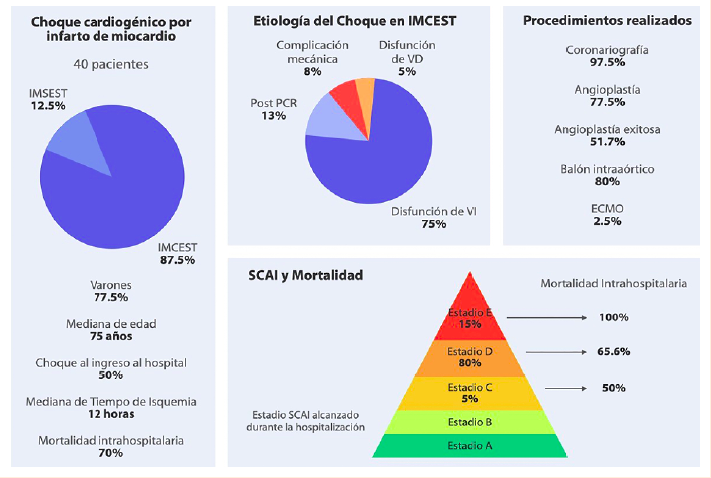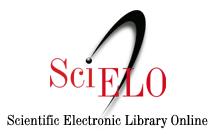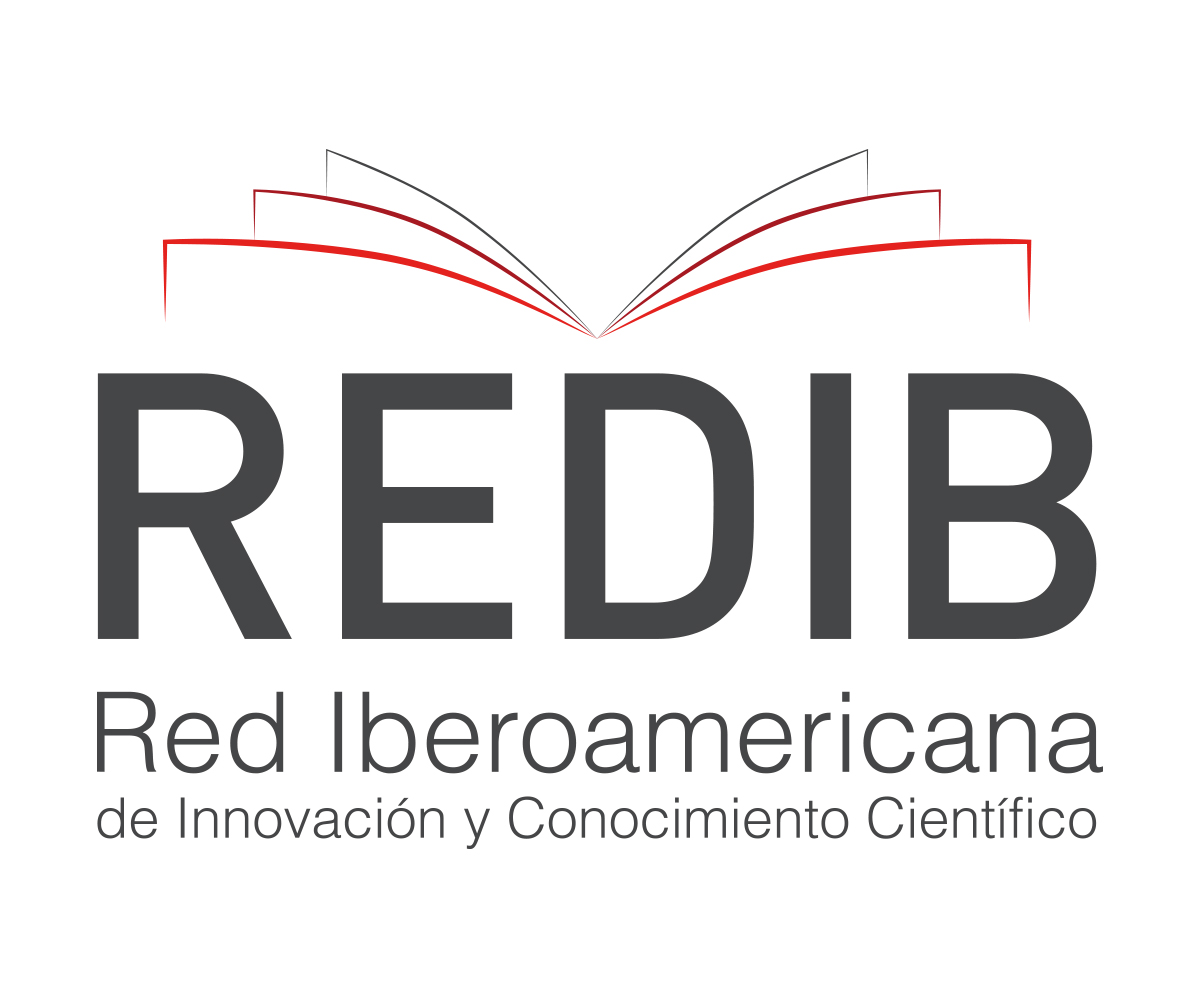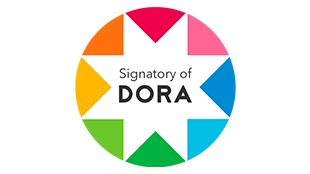Current features and mortality risk factors in cardiogenic shock due to miocardial infarction in a Latin-american hospital
DOI:
https://doi.org/10.47487/apcyccv.v1i4.89Keywords:
Cardiogenic shock, Myocardial infarction, Mortality, PeruAbstract
Objective. To know the clinical characteristics and determine the related factors to higher in-hospital mortality in patients with cardiogenic shock (CS) due to myocardial infarction in a Peruvian reference hospital.
Materials and methods. We conducted a prospective single-center cohort study, to evaluate the clinical characteristics, treatment, and complications of patients with CS due to myocardial infarction from March 2019 to August 2020 at the Instituto Nacional Cardiovascular INCOR. Factors related to higher in-hospital mortality and during follow-up were evaluated. Also, the IABP shock II score was applied to stratify the cohort.
Results. Forty patients were included in the study, 75% of cases were due to left ventricular dysfunction, most of the men and with a median age of 75 (69-82) years. Fifty percent of cases presented CS after admission to the emergency room. Patients stratified by the IABP shock II score as low, intermediate, and high risk, had in-hospital mortality of 37.5%, 71.4%, and 91.6% respectively. In a hospital, mortality was 70%, higher in women, in those over 75 years old, and in those who developed CS during their hospitalization. Serum lactate > 4 mmol/L in univariate analysis was associated with higher mortality risk (HR: 2.8; IC:1.6-3.6, p=0.009). Survival to the end of the study was 12.8%.
Conclusions. CS due to myocardial infarction is a clinical entity with high mortality in spite of revascularization and the available treatment in our reality. The highest mortality predictor was the serum lactate at admission >4 mmol/L. The IABP shock II score showed to be an accurate parameter to stratify the death risk in our population.
Downloads
References
Zeymer U, Bueno H, Granger CB, et al. Acute Cardiovascular Care Association position statement for the diagnosis and treatment of patients with acute myocardial infarction complicated by cardiogenic shock : A document of the Acute Cardiovascular Care Association of the European Society of Car. 2020;183–97.
Aissaoui N, Puymirat E, Tabone X, et al. Improved outcome of cardiogenic shock at the acute stage of myocardial infarction: A report from the USIK 1995, USIC 2000, and FAST-MI French Nationwide Registries. Eur Heart J [Internet]. octubre de 2012 [citado el 16 de septiembre de 2020];33(20):2535–43. Disponible en: https://pubmed.ncbi.nlm.nih.gov/22927559/
Pöss J, Köster J, Fuernau G, et al. Risk Stratification for Patients in Cardiogenic Shock After Acute Myocardial Infarction. J Am Coll Cardiol [Internet]. el 18 de abril de 2017 [citado el 16 de septiembre de 2020];69(15):1913–20. Disponible en: https://pubmed.ncbi.nlm.nih.gov/28408020/
Chacón-Diaz M, Vega A, Aráoz O, et al. Epidemiological characteristics of ST-segment elevation myocardial infarction in Peru: Results of the peruvian registry of ST-segment elevation myocardial infarction (PERSTEMI). Arch Cardiol Mex. el 1 de diciembre de 2018;88(5):403–12. https://doi.org/10.1016/j.acmx.2017.11.009
Chacón-Diaz M, Araoz-Tarco O, Alarco-León W,et al. Heart failure complicating myocardial infarction. A report of the peruvian registry of ST-elevation myocardial infarction (PERSTEMI). Arch Cardiol Mex. el 1 de diciembre de 2018;88(5):447–53. https://doi.org/10.1016/j.acmx.2018.03.007
Thiele H, Zeymer U, Neumann F-J, et al. Intraaortic Balloon Support for Myocardial Infarction with Cardiogenic Shock. N Engl J Med [Internet]. 4 de octubre de 2012 [citado 19 de octubre de 2020];367(14):1287-96. Disponible en: http://www.nejm.org/doi/10.1056/NEJMoa1208410
Baran D, Grines C, Bailey S, et al. SCAI clinical expert consensus statement on the classification of cardiogenic shock. Catheter Cardiovasc Interv. 2019;94(1):29-37. doi: 10.1002/ccd.28329.
Castillo Y, Garcia M, Mauro V, et al. Registro Nacional Argentino de Shock Cardiogénico (ReNa-SHOCK). Rev Argen Cardiol. 2016;84:228-35.
Hidalgo-Olivares VM, Córdoba-Soriano JG, López-Neira I, et al. Influencia de la edad en el pronóstico a corto y largo plazo del choque cardiogénico de origen isquémico. Archivos de Cardiología de México [Internet]. enero de 2014 [citado 25 de octubre de 2020];84(1):10-6. Disponible en DOI: 10.1016/j.acmx.2013.10.005
Obling L, Frydland M, Hansen R, et al. Risk factors of late cardiogenic shock and mortality in ST-segment elevation myocardial infarction patients. European Heart Journal: Acute Cardiovascular Care [Internet]. febrero de 2018 [citado 25 de octubre de 2020];7(1):7-15. Disponible en: http://journals.sagepub.com/doi/10.1177/2048872617706503
Lindholm M, Køber L, Boesgaard S et al. Cardiogenic shock complicating acute myocardial infarction. Prognostic impact of early and late shock development. European Heart Journal [Internet]. febrero de 2003 [citado 25 de octubre de 2020];24(3):258-65. Disponible en: https://academic.oup.com/eurheartj/article-lookup/doi/10.1016/S0195-668X(02)00429-3
Collet J, Thiele H, Barbato E, et al. 2020 ESC Guidelines for the management of acute coronary syndromes in patients presenting without persistent ST-segment elevation. European Heart Journal, ehaa575. Disponible en: https://doi.org/10.1093/eurheartj/ehaa575
Ibáñez B, James S, Agewall S, et al. Guía ESC 2017 sobre el tratamiento del infarto agudo de miocardio en pacientes con elevación del segmento ST. Revista Española de Cardiología [Internet]. diciembre de 2017 [citado25 de octubre de 2020];70(12):1082.e1-1082.e61. Disponible en: https://linkinghub.elsevier.com/retrieve/pii/S0300893217306693
Thiele H, Ohman EM, de Waha-Thiele S, et al. Management of cardiogenic shock complicating myocardial infarction: an update 2019. European Heart Journal [Internet]. 21 de agosto de 2019 [citado 25 de octubre de 2020];40(32):2671-83. Disponible en: https://academic.oup.com/eurheartj/article/40/32/2671/5528526
Valdebenito M, Veas N, Lindefjeld D, Winter JL, Guarda E, Pérez O, et al. Características clínicas, predictores de mortalidad y resultados inmediatos y a largo plazo en el tratamiento con angioplastía primaria del infarto agudo al miocardio con supradesnivel del ST complicado con shock cardiogénico. Rev Chil Cardiol [Internet]. 2014 [citado 25 de octubre de 2020];33(2):116-22. Disponible en: http://www.scielo.cl/scielo.php?script=sci_arttext&pid=S0718-85602014000200005&lng=en&nrm=iso&tlng=en
Thiele H, Akin I, Sandri M, Fuernau G, de Waha S, Meyer-Saraei R, et al. PCI Strategies in Patients with Acute Myocardial Infarction and Cardiogenic Shock. N Engl J Med [Internet]. 21 de diciembre de 2017 [citado 25 de octubre de 2020];377(25):2419-32. Disponible en: http://www.nejm.org/doi/10.1056/NEJMoa1710261
Martinez-Sanchez C, Borrayo G, Carrillo J, et al. Clinical management and hospital outcomes of acute coronary syndrome patients in Mexico: The Third National Registry of Acute Coronary Syndromes (RENASICA III). Archivos de Cardiología de México [Internet]. julio de 2016 [citado 19 de octubre de 2020];86(3):221-32. Disponible en: http://www.archivoscardiologia.com/previos/(2016)%20ACM%20Vol%2086.%203%20JULIO-SEPTIEMBRE/ACMX_2016_86_3_221-232.pdf
Udesen NJ, Møller JE, Lindholm MG, et al. Rationale and design of DanGer shock: Danish-German cardiogenic shock trial. American Heart Journal [Internet]. agosto de 2019 [citado 25 de octubre de 2020];214:60-8. Disponible en: https://linkinghub.elsevier.com/retrieve/pii/S0002870319301085
Kapur NK, Davila CD. Timing, timing, timing: the emerging concept of the ‘door to support’ time for cardiogenic shock. European Heart Journal [Internet]. 14 de diciembre de 2017 [citado 25 de octubre de 2020];38(47):3532-4. Disponible en: http://academic.oup.com/eurheartj/article/38/47/3532/4035736
Harjola V-P, Lassus J, Sionis A, et al. Clinical picture and risk prediction of short-term mortality in cardiogenic shock: Clinical picture and outcome of cardiogenic shock. Eur J Heart Fail [Internet]. mayo de 2015 [citado 25 de octubre de 2020];17(5):501-9. Disponible en:http://doi.wiley.com/10.1002/ejhf.260
Fuernau G, Desch S, de Waha-Thiele S, et al. Arterial Lactate in Cardiogenic Shock. JACC: Cardiovascular Interventions [Internet]. octubre de 2020 [citado 25 de octubre de 2020];13(19):2208-16. Disponible en: https://linkinghub.elsevier.com/retrieve/pii/S1936879820313923
Jentzer J, van Diepen S, Barsness G, et al. Cardiogenic Shock Classification to Predict Mortality in the Cardiac Intensive Care Unit. J Am Coll Cardiol. 2019 Oct 29;74(17):2117-28. doi: 10.1016/j.jacc.2019.07.077. Epub 2019 Sep 20.
Sakamoto K, Matoba T, Mohri M, et al. Clinical characteristics and prognostic factors in acute coronary syndrome patients complicated with cardiogenic shock in Japan: analysis from the Japanese Circulation Society Cardiovascular Shock Registry. Heart Vessels [Internet]. agosto de 2019 [citado 25 de octubre de 2020];34(8):1241-9. Disponible en: http://link.springer.com/10.1007/s00380-019-01354-9.


















